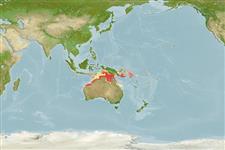Пластиножаберные (акулы и скаты) (sharks and rays) >
Myliobatiformes (Stingrays) >
Dasyatidae (Stingrays) > Neotrygoninae
Etymology: More on author: Last.
Environment: milieu / climate zone / depth range / distribution range
экология
морской демерсальный; пределы глубины 5 - 80 m (Ref. 9840). Deep-water; 4°S - 21°S
Western Pacific: northern Australia and New Guinea, including the Arafura Sea and Timor Sea.
Size / Вес / Возраст
Maturity: Lm ? range ? - ? cm
Max length : 25.0 cm WD самец/пол неопределен; (Ref. 6871)
Found on the continental shelf (Ref. 6871, 75154). Size at birth about 11 cm WD (Ref. 6871). Exists as two color forms. Ovoviviparous (Ref. 50449).
Life cycle and mating behavior
Maturities | размножение | Spawnings | Egg(s) | Fecundities | личинки
Exhibit ovoviparity (aplacental viviparity), with embryos feeding initially on yolk, then receiving additional nourishment from the mother by indirect absorption of uterine fluid enriched with mucus, fat or protein through specialised structures (Ref. 50449). Distinct pairing with embrace (Ref. 205).
Last, P.R. and J.D. Stevens, 1994. Sharks and rays of Australia. CSIRO, Australia. 513 p. (Ref. 6871)
Статус Красного Списка МСОП (Ref. 130435)
Угроза для людей
Harmless
Использование человеком
рыболовство: интереса не представляет
дополнительная информация
инструменты
Специальные отчеты
Скачать в формате XML
ресурсы в Интернет
Estimates based on models
Preferred temperature (Ref.
123201): 26.2 - 28.6, mean 27.7 °C (based on 312 cells).
Phylogenetic diversity index (Ref.
82804): PD
50 = 0.5039 [Uniqueness, from 0.5 = low to 2.0 = high].
Bayesian length-weight: a=0.01096 (0.00342 - 0.03513), b=3.11 (2.86 - 3.36), in cm total length, based on LWR estimates for this (Sub)family-body shape (Ref.
93245).
Trophic level (Ref.
69278): 3.4 ±0.3 se; based on size and trophs of closest relatives
устойчивость к внешним воздействиям (Ref.
120179): низкий, минимальное время удвоения популяции 4.5-14 лет (Assuming fecundity<100).
Fishing Vulnerability (Ref.
59153): Moderate vulnerability (40 of 100).
